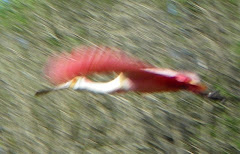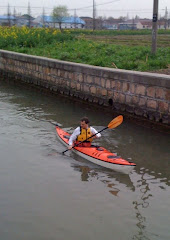What is Sculling?
I don't mean saying cheers in Swedish: skål, or Icelandic: skál. Sculling is a term used to describe two ways of propelling a boat using oars. One of those can also be used to propel a boat using a paddle. As a kayaker and canoeist, I'll focus on efficient paddle technique, but here is some context first.
Sculling or rowing?
Technically, there is a difference between sculling and
rowing, particularly in competition, although the two terms are often used indiscriminately. Rowing (or sweep rowing) requires
at least two oars, one oar for each rower. In other words, at least two people are needed to row, one oar each side. Only one person is needed to scull, using a pair of oars, one in
each hand. But there is another way to scull. A single person can propel a
boat using a to-and-fro movement with one oar, usually over the stern, although sometimes at the bow or over the side.
Grab and pull method. (Or grab and push).
The sculler, facing the stern of the craft, grabs the water
with both blades and pulls against them to propel the boat forward. The
familiar sight of racing sculls with the scullers sitting low to the water, facing the stern using two oars, is a classic example, but many people scull
small boats using two oars while facing forward. In this case the sculler grabs
the water with both blades and pushes the craft forward.
 |
The three scullers facing the stern of the green boat work two oars each. The helmsperson (coxswain) in the back faces forward. Venice Italy. |
Side-to side method, single oar.
The sculler swings a single oar thwartwise (from side to side) with the blade aligned to push the boat forward with every sideways swing.
Sculling a sampan with a single oar over the stern, using a side-to-side movement. Suzhou China.
A combination of the two techniques
Gondoliers use a modified version of sculling, using a single oar while standing in the stern facing the bow. They use the scull with a rowlock (the forcola) to one side of the stern, using a combination of the “grab the water and pull” action, and the “to-and-fro” movement. They never switch sides and mostly keep the blade in the water during recovery between strokes. The gondola is asymmetrical to make steering easier since the gondolier uses the oar to both propel and steer, always on the same side. The elevated position of the gondolier allows the oar blade to stay closer to the hull, making the gondola easier to navigate through the narrow Venetian canals. A sculler in a racing scull sits low, the oars reaching wide.
 |
A gondolier sculls using a single oar to one side of the hull near the stern. Venice Italy. |
Over-stern sculling
 |
Sculling a Sampan with single oar blade in pushing mode at stern, Suzhou China (Above and in Video below) |
Over the bow sculling
Coracles are circular, bowl shaped, so the bow in this case is more of a
concept rather than a design feature. The paddler kneels or sits, sculling the
craft with the face of the blade engaged, in pulling mode at the front. The
coracle is used for fishing with a net, when the short paddle used single-handedly
frees the other hand to work the net. Coracle - Wikipedia.
The sculling draw, to move sideways.
Canoeists and kayakers use sculling to pull their craft
sideways with the face of the blade engaged. (We also use a similar blade action
but starting with the blade flat on the water and moving the blade across the
surface in the manner of a knife spreading butter, to aid or to recover balance.
I’ll go into how to use that, another time.)
The blade action is a to-and-fro movement, with a slight
adjustment of blade angle with each swing. The blade movement is most easily
understood if we first imagine a pendulum action with the blade in neutral. That
is, sliced edge-first with no pressure on either the face or the back of the
blade.
If we angle the leading edge of the blade slightly away during
each swing of the pendulum, the blade will try to climb sideways away from us.
This is the pulling mode. This is the style used to pull a canoe or kayak
sideways, or a coracle forward.
 |
Pulling mode, here dragging the dock toward the right. For clarity, blade is shown partly immersed but it should be fully immersed when in action |
If we angle the leading edge of the blade slightly closer
to us than the trailing edge, the blade will try to climb sideways closer to
us. This is the pushing mode, used for over-stern propulsion, and also to push
a kayak or canoe sideways.
 |
Pushing mode, here pushing the dock toward the left. For clarity, blade is shown partially immersed. It should be fully immersed in action. |
Refining the paddle stroke.
Keep blade upright to go sideways, or flat to aid support.
The stroke is most effective at pulling the craft sideways
when the blade is held upright: perpendicular to the water, with the blade
fully immersed. The closer the blade
angle approaches horizontal, the less effective it gets at pulling sideways; it
climbs to the surface rather than sideways from the craft. When it climbs to
the surface it may be used to aid balance or recover it. A 45-degree angle to
the water surface will offer a lot less sideways pulling effect
compared to a 90-degree angle.
Here, the blade is used one-handed in pulling mode, the shallow water necessitating a low blade angle to the water of about 45°. While less effective at this angle, you'll notice it did offer some balance support. Lake Toba Indonesia
Positioning the top hand directly above the
bottom hand throughout the stroke will prioritize the sideways pull, while lowering the top hand to the
level of the deck will make the blade more useful in maintaining balance.
To maximize sideways movement, rotate your torso to face your direction of travel, hold your top arm straight, horizontal at shoulder level, over the water perpendicular to the side of the kayak. Control the blade angle with your lower hand. Pause momentarily at the end of each swing while you change the blade angle.
Try using the paddle in the manner of a pendulum, with the top
hand in a fixed position and compare the effectiveness to when you move both
arms together, keeping the top hand vertically above the bottom hand. Does
torso rotation help your draw stroke?
Figure of eight.
Steering while moving sideways
You can steer by sculling with a lesser blade angle in one
direction than in the other. You can also turn by sculling only at one end of
the craft, leaving the other end almost stationary. Play with it!
Find more tricks and tips in my book, The Art of Kayaking.
Learn more about the author at nigelkayaks.com
.JPG)



































No comments:
Post a Comment